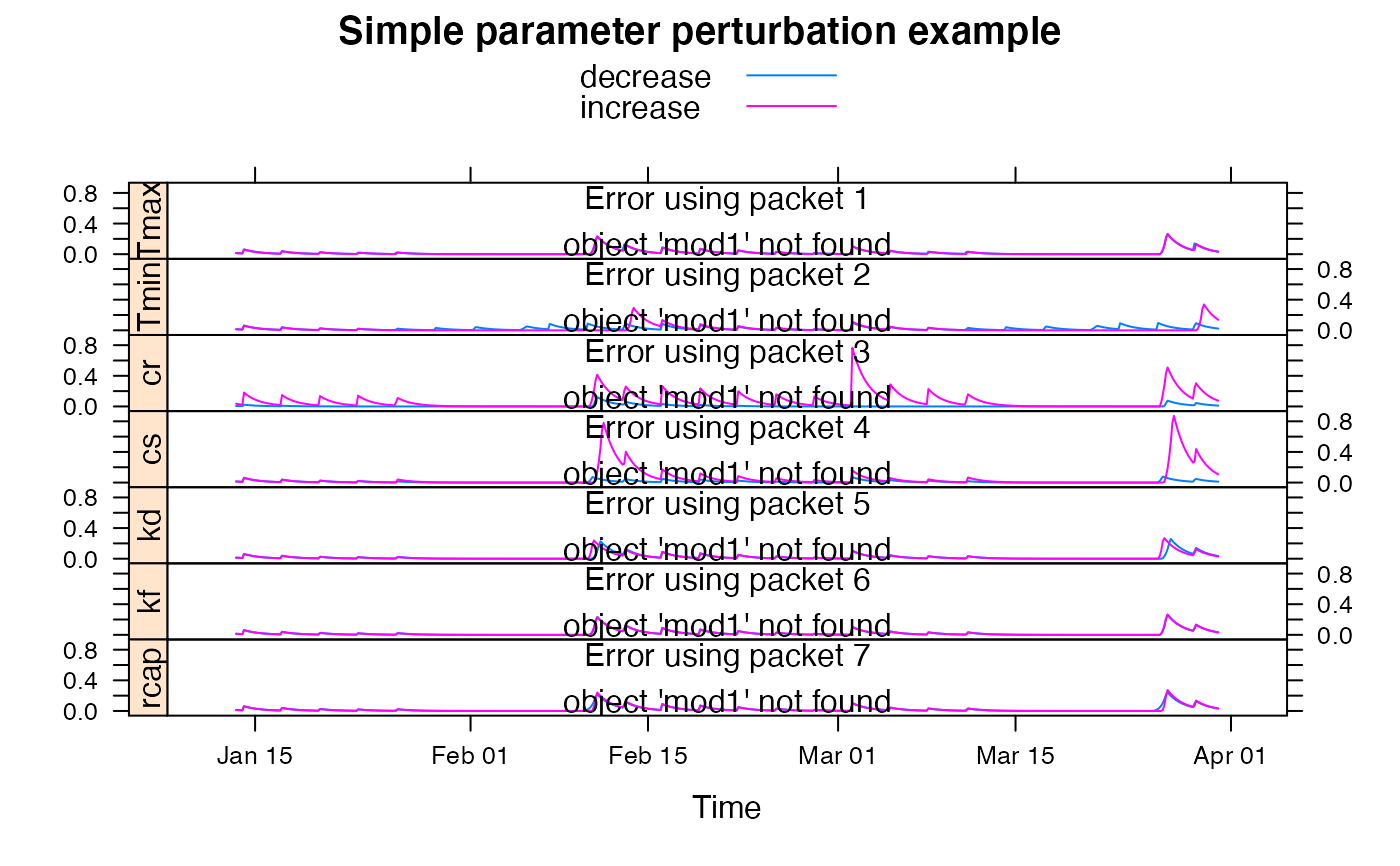Simple degree day factor snow model coupled with IHACRES CMD soil moisture model.
snow.sim(
DATA,
Tmax,
Tmin,
kd,
kf,
rcap,
Tmelt = Tmin,
cr = 1,
cs = 1,
LSWE_0 = 0,
ISWE_0 = 0,
...,
return_state = FALSE
)Arguments
- DATA
a
ts-like object with named columns:- list("P")
time series of areal rainfall depths, usually in mm.
- list("E")
time series of potential evapo-transpiration, or more typically, temperature as an indicator of this.
- Tmax
temperature threshold for rain, all rain is liquid above this threshold.
- Tmin
temperature threshold for rain, all rain is snow below this threshold.
- kd
degree day factor for snowmelt.
- kf
degree day factor for freezing.
- rcap
retention parameter for liquid water capacity of snowpack.
- Tmelt
temperature threshold for snowmelt and freezing in the snowpack.
- cr
correction factor for rainfall.
- cs
correction factor for snowfall.
- LSWE_0, ISWE_0
initial values of state variables.
- ...
parameters for the IHACRES.CMD.model.
- return_state
to return state variables as well as the effective rainfall.
Value
snow.sim returns the modelled time series of effective
rainfall, or if return_state = TRUE, a multi-variate time series with
named columns U (effective rainfall), SWE (snow water
equivalent) and TF, as well as the CMD state variables.
Details
SWE snow water equivalent
ISWE water equivalent of ice in the snowpack
LSWE liquid water retained in the snowpack
References
Kokkonen T., Jakeman A.J, Koivusalo.H, Norton.J.: COMPUTATIONAL METHODS FOR WATER RESOURCE ASSESSMENTS: AN EXERCISE KIT Educational Series on Modelling and Software iEMSs International Modelling and Software Society Available through www.iemss.org
See also
hydromad(sma = "snow") to work with models as objects
(recommended).
Examples
## view default parameter ranges:
str(hydromad.options("snow"))
#> List of 1
#> $ snow:List of 10
#> ..$ Tmax: num [1:2] 0 2
#> ..$ Tmin: num [1:2] -1 1
#> ..$ cr : num [1:2] 0.8 2
#> ..$ cs : num [1:2] 0.8 2
#> ..$ kd : num [1:2] 2 5
#> ..$ kf : num [1:2] 0 2
#> ..$ rcap: num [1:2] 0 1
#> ..$ f : num [1:2] 0.01 3
#> ..$ e : num [1:2] 0.01 1.5
#> ..$ d : num 200
data(HydroTestData)
mod0 <- hydromad(HydroTestData, sma = "snow", routing = "expuh")
mod0
#>
#> Hydromad model with "snow" SMA and "expuh" routing:
#> Start = 2000-01-01, End = 2000-03-31
#>
#> SMA Parameters:
#> lower upper
#> Tmax 0.00 2.0
#> Tmin -1.00 1.0
#> cr 0.80 2.0
#> cs 0.80 2.0
#> kd 2.00 5.0
#> kf 0.00 2.0
#> rcap 0.00 1.0
#> f 0.01 3.0
#> e 0.01 1.5
#> d 200.00 200.0 (==)
#> Routing Parameters:
#> NULL
## simulate with some arbitrary parameter values
mod1 <- update(mod0,
Tmax = 15, Tmin = 5, cr = 1, cs = 1,
kd = 3, kf = 1, rcap = 0.5,
d = 200, f = 0.5, e = 0.1, tau_s = 10
)
## plot results with state variables
testQ <- predict(mod1, return_state = TRUE)
xyplot(cbind(HydroTestData[, 1:2], snow = testQ))
 ## show effect of increase/decrease in each parameter
parlist <- list(
Tmax = c(10, 20), Tmin = c(0, 10),
cr = c(0.5, 2), cs = c(0.5, 2),
kd = c(2, 5), kf = c(0, 2), rcap = c(0, 1)
)
parsims <- mapply(
val = parlist, nm = names(parlist),
FUN = function(val, nm) {
lopar <- min(val)
hipar <- max(val)
names(lopar) <- names(hipar) <- nm
fitted(runlist(
decrease = update(mod1, newpars = lopar),
increase = update(mod1, newpars = hipar)
))
}, SIMPLIFY = FALSE
)
xyplot.list(parsims,
superpose = TRUE, layout = c(1, NA),
strip = FALSE, strip.left = TRUE,
main = "Simple parameter perturbation example"
) +
latticeExtra::layer(panel.lines(fitted(mod1), col = "grey", lwd = 2))
## show effect of increase/decrease in each parameter
parlist <- list(
Tmax = c(10, 20), Tmin = c(0, 10),
cr = c(0.5, 2), cs = c(0.5, 2),
kd = c(2, 5), kf = c(0, 2), rcap = c(0, 1)
)
parsims <- mapply(
val = parlist, nm = names(parlist),
FUN = function(val, nm) {
lopar <- min(val)
hipar <- max(val)
names(lopar) <- names(hipar) <- nm
fitted(runlist(
decrease = update(mod1, newpars = lopar),
increase = update(mod1, newpars = hipar)
))
}, SIMPLIFY = FALSE
)
xyplot.list(parsims,
superpose = TRUE, layout = c(1, NA),
strip = FALSE, strip.left = TRUE,
main = "Simple parameter perturbation example"
) +
latticeExtra::layer(panel.lines(fitted(mod1), col = "grey", lwd = 2))
